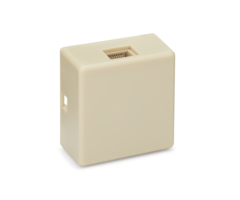How Do I Wire a POTS Line to My Security System?
You can wire a POTS line to your security system by first wiring an incoming phone line to an RJ jack. The RJ jack will then connect to the on-site landline phones and to the alarm system. Your security system must be compatible with pots service in order to use this type of communication.
POTS stands for plain old telephone service. It was once the most common communication path for alarm systems. Today, it has largely been replaced in favor of IP and cellular communication. But some users continue to use a POTS connection with their alarm systems. Before attempting to set up a POTS line, make sure that your alarm system can support this type of communication. Most newer alarm systems are IP and cellular only.
The benefit of POTS is that a user can sign up for our Bronze level monitoring plan, which does not support IP or cellular communication. Please note that the Bronze plan is extremely limited and basic, and it does not provide many of the features and capabilities offered from higher level monitoring plans. The biggest limitation of a POTS line is that the system will be unable to use any interactive services, such as Total Connect or Alarm.com.
One thing that makes a POTS connection for an alarm system unique is that the system uses a technique known as "line seizure". This means that when the alarm is attempting to dial out, all of the other phones connected to the line will temporarily stop working. This will ensure that the system is able to dial out and that nothing else will get in its way.
To complete the wiring process, you will need to purchase an RJ jack separately. The RJ jack allows the panel to be quickly removed from the phone line so that the phone can be used. This is good for situations in which the alarm panel refuses to release the phone line so that the telephone can be used. We recommend using the Ultratech RJ31XSET. This device also includes a direct connect cord so that can more easily connect with the security system itself.
The complete look at a POTS setup can be seen in the following diagram:

The process of wiring a POTS line starts with the incoming line from the telephone company. This line consists of two parts, the ring and the tip. The ring connects to terminal 4 (red) on the RJ Jack. The tip connects to terminal 5 (green) on the RJ Jack.
The outgoing lines from the RJ Jack connect to the on-site telephones. Again, these are referred to as the ring and tip. The ring connects to terminal 1 (grey) on the RJ jack. The tip connects to terminal 8 (brown) on the RJ jack.
The alarm system will also connect directly to the RJ jack. This is done using a direct connect cord that plugs into the RJ jack. The direct connect cord is typically provided with the RJ jack. The direct connect cord consists of two ends, one of which is a direct connector for the RJ jack. It is just a simple plug-in. If the phone line for the panel ever needs to be cut, this module can be easily unplugged to disconnect the line.
The other end of the cord consists of four leads that connect with terminals on the panel. The brown wire connects with the Handset Tip. The grey wire connects with the Handset Ring. The green wire connects with the Telephone Line Tip. The red wire connects with the Telephone Line Ring.
Additionally, the panel itself includes a special built-in relay for the POTS connection. This relay internally connects directly to the four terminals on the alarm system. When the panel needs to dial out, the relay automatically activates. This cuts off the house side phones and seizes the phone line. This is what allows the alarm system to take over the phone line from any on-site landline phones when dialing out. Basically, it ensures that the system will always be able to successfully dial out, even if the phones are in use. This relay does not need to be set up by the end user, but it can be helpful to understand what function it serves.
Did you find this answer useful?
We offer alarm monitoring as low as $10 / month
Click Here to Learn MoreRelated Products

Related Categories
- Answered
